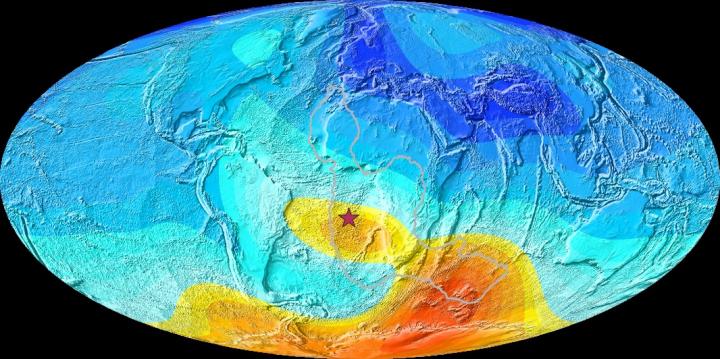Weird behavior of Earth's magnetic field over South Atlantic dates back 11 million years
What's the deal with the South Atlantic anomaly?

Strange behavior in Earth's magnetic field over the South Atlantic region can be traced back as far as 11 million years ago, and it's unlikely to cause any impending reversal of Earth's magnetic field, a new study shows.
The South Atlantic Anomaly is a weak spot in Earth's magnetic field, which protects the planet from high doses of solar wind and cosmic radiation. This anomaly exists because the Earth's inner Van Allen radiation belt comes closest to the planet’s surface, causing an increased flux of energetic particles. In turn, this anomaly also causes technical disturbances in satellites and spacecraft orbiting Earth.
Researchers from the University of Liverpool in England studied igneous, or volcanic rocks from the island Saint Helena, which lies in the South Atlantic Anomaly. Records of Earth's magnetic field are preserved in igneous rocks, offering a detailed view of the planet's magnetic history.
Related: 'Vigorous' magnetic field oddity spotted over South Atlantic
"Our study provides the first long term analysis of the magnetic field in this region dating back millions of years," Yael Engbers, lead author of the study, said in a statement. "It reveals that the anomaly in the magnetic field in the South Atlantic is not a one-off, similar anomalies existed eight to 11 million years ago."
Researchers studied rocks from 34 volcanic eruptions that occurred at Saint Helena between 8 and 11 million years ago. When volcanic rocks cool down, small grains of iron-oxide in them get magnetized, preserving the direction and strength of the Earth’s magnetic field at that time and place.
Earth's magnetic field lines run from south to north. The geomagnetic records from the rocks show that the magnetic field at Saint Helena has pointed in different directions during past eruptions. This suggests that the magnetic field in this region has been unstable for millions of years.
Get the Space.com Newsletter
Breaking space news, the latest updates on rocket launches, skywatching events and more!
Earth's magnetic field changes in strength and direction over time. It is believed that these fluctuations may eventually trigger a reversal of the Earth's magnetic field. However, given that the magnetic field at the region of the South Atlantic Anomaly has been unstable for several million years, it is not likely associated with any such impending reversal, according to the statement.
"It also supports earlier studies that hint towards a link between the South Atlantic Anomaly and anomalous seismic features in the lowermost mantle and the outer core," Engbers said in the statement. "This brings us closer to linking behavior of the geomagnetic field directly to features of the Earth's interior."
Their findings were published July 20 in the Proceedings of the National Academy of Sciences.
Follow Samantha Mathewson @Sam_Ashley13. Follow us on Twitter @Spacedotcom and on Facebook.
Join our Space Forums to keep talking space on the latest missions, night sky and more! And if you have a news tip, correction or comment, let us know at: community@space.com.

Samantha Mathewson joined Space.com as an intern in the summer of 2016. She received a B.A. in Journalism and Environmental Science at the University of New Haven, in Connecticut. Previously, her work has been published in Nature World News. When not writing or reading about science, Samantha enjoys traveling to new places and taking photos! You can follow her on Twitter @Sam_Ashley13.









